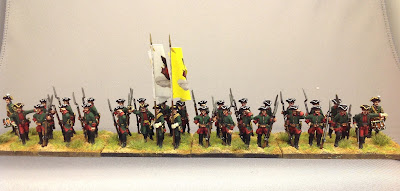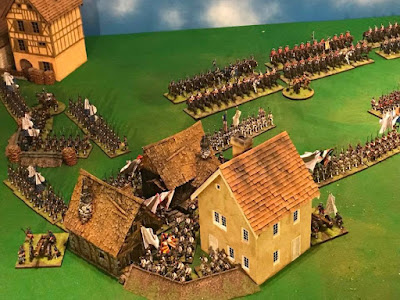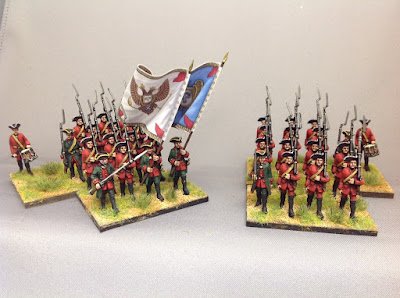I finished another battalion of SYW Russian infantry for my Zorndorf Project, this time a musketeer battalion in the Observation Corps. I used some of the Minden Russian artillery crew figures and gave them some muskets so that they look like a battalion of soldiers that are standing "at ease" waiting for orders or resting until the battle comes to them. The flags were copied from the Kronoskaf web site.
I recruited the standard bearers and drummers from the Fife & Drum AWI Hessian musketeer range of figures. The two NCOs (pointing) and the officer holding his sword over his head (why oh why do they do this?) are Minden Prussian jagers. Finally, the officer standing next to the colour bearer is one of the Austrian officers from the dismounted staff set of figures.
 |
| The 5th Musketeer Regiment in the Russian Observation Corps. CLICK the picture to enlarge. |
I had to kind of "fudge" things a little bit since none of the figures' uniforms are exactly correct. For example, most of them are not wearing the cavalry boots that the soldiers wore. If anyone wants to call me out on this and complain, then my story is that they were recently issued shoes and gaitors and got rid of the cumbersome cavalry boots. Also, the regiment probably left their green coats back at the baggage park and fought in their red sleeved waistcoats since Zorndorf was fought in August. However, the artillery crew figures are wearing the belly box cartridge box which makes them good candidates to be used as Observation Corps figures.
The officers all have boots so I did not have to make any changes to them. I added some green epoxy putty to the gaitors on the standard bearers to turn them into cavalry boots.
I am happy with the way that this unit turned out. When I first saw the artillery crew figures, my first thought was "these guys look similar to the Observation Corps soldiers". Fortunately, I had some spare muskets that I could put in their hands to make them infantry. I think that I might add these figures, muskets in hand, to the Minden range so that they can be used as Russian artillery fusiliers, which were attached to the artillery companies to provide some protection for the crewmen in case the enemy got too close.
Regimental History
Click on the link below to read about the history of the regiment, courtesy of the Kronoskaf web site.
In 1756, the Observation Corps was still recruiting and organising in Moscow and did not take part in the campaign.
In the Autumn of 1757, the regiment (only 3 battalions instead of the 4 battalions originally planned), initially stationed in Moscow, was sent to Novgorod.
In January 1758, the Observation Corps was finally ready and marched to the theatre of operation. Then the 3 battalions of the regiment took part in the Russian invasion of East Prussia. In July, the Observation Corps could align only 12,000 men. On August 6, during the invasion of Brandenburg, it marched from Paradise Kloster through Birnbaum to Schwerin on the Wartha river where it encamped. On August 10, Czernichef was instructed to march from Schwerin to Landsberg with the Observation Corps. On August 23, the Observation Corps marched from Landsberg to make a junction with Fermor's main army at Zorndorf. The junction was made at 2:00 PM on August 24 and the Observation Corps was deployed en potence on the flank facing Quartschen. On August 25, the regiment took part in the battle of Zorndorf where it was deployed in Thiessen's Brigade in the first line of the Observation Corps. About mid November, the regiment took its winter quarters in an area extending from Thorn (present-day Torun) to Culm (present-day Chelmno) as part of Braun's corps.
On July 23 1759, the regiment took part in the battle of Paltzig where it was attached to Golitsyn Observation Corps. It was deployed in the first line of the left wing. A few weeks later, on August 12, the regiment fought in the bloody battle of Kunersdorf where it was deployed in the first line of the left wing as part of Essen's Brigade. During this battle the Observation Corps suffered so heavily that it was no longer able to operate as an autonomous corps.
At the beginning of 1760, the entire Observation Corps was disbanded and its troops integrated into the Fusilier Regiments of the Artillery.
By the way, if you are not already familiar with Kronoskaf, then by all means click on the link and look at the vast array of information that they have collected about the Seven Years War.
 |
| A close-up view of the battalion. |
With the completion of this battalion, I now have 9 of the 12 battalions that I will need for my Russian army in my scaled down version of Zorndorf, which will be played at the upcoming Seven Years War Association convention (April 5-6, 2018 in South Bend, IN).





















































